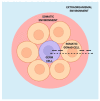What Is Lost in the Weismann Barrier?
- PMID: 33339122
- PMCID: PMC7768413
- DOI: 10.3390/jdb8040035
What Is Lost in the Weismann Barrier?
Abstract
The Weismann barrier has long been regarded as a basic tenet of biology. However, upon close examination of its historical origins and August Weismann's own writings, questions arise as to whether such a status is warranted. As scientific research has advanced, the persistence of the concept of the barrier has left us with the same dichotomies Weismann contended with over 100 years ago: germ or soma, gene or environment, hard or soft inheritance. These dichotomies distract from the more important questions we need to address going forward. In this review, we will examine the theories that have shaped Weismann's thinking, how the concept of the Weismann barrier emerged, and the limitations that it carries. We will contrast the principles underlying the barrier with recent and less recent findings in developmental biology and transgenerational epigenetic inheritance that have profoundly eroded the oppositional view of germline vs. soma. Discarding the barrier allows us to examine the interactive processes and their response to environmental context that generate germ cells in the first place, determine the entirety of what is inherited through them, and set the trajectory for the health status of the progeny they bear.
Keywords: Weismann barrier; germ cells; germline; soma; transgenerational epigenetic inheritance.
Conflict of interest statement
The authors declare no conflict of interest.
Figures



References
-
- Churchill F.B. August Weismann, and a break from tradition. J. Hist. Biol. 1968;1:91–112. doi: 10.1007/BF00149777. - DOI
-
- Weismann A. The Germplasm: A Theory of Heredity. Charles Scribner’s Sons; New York, NY, USA: 1893.
Publication types
Grants and funding
LinkOut - more resources
Full Text Sources
Research Materials

